Sowing rules and features of growing Japanese cabbage (mizuna)
Japanese cabbage, or mizuna, is a type of kale. In appearance, it resembles arugula, but more delicate in taste, without bitterness. The culture is very decorative - flower arrangements are made from it in flower beds. The vegetable is added to salads, sandwiches, pie fillings.
In Russia, its cultivation began relatively recently. Therefore, we will tell you in detail about this culture, the methods of breeding it and the nuances of care.
The content of the article
What is Japanese cabbage
Japanese cabbage, lettuce, mustard, Mitsuna, Mizuna, Mizuna - all these are the names of a plant with carved leaves from the Cruciferous family.... The culture does not form a head - only a rosette of leaves and an edible long root crop.
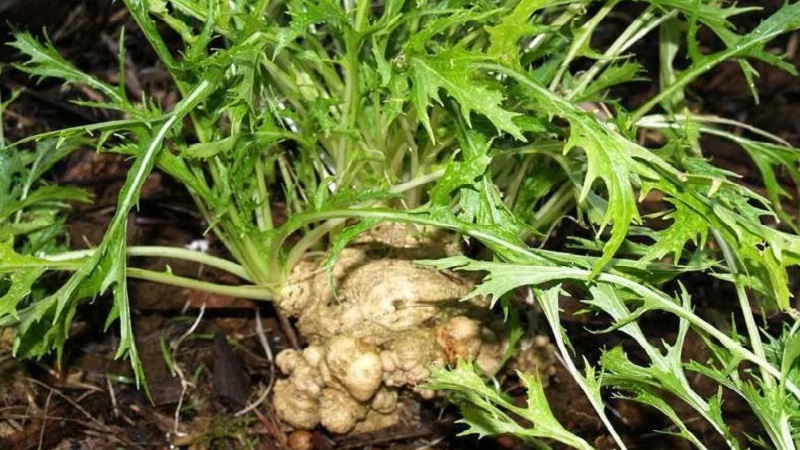
Cabbage is especially popular in China and Japan and has been cultivated there for several centuries.... Widely distributed in Europe, North America, Australia.
Leaves on thin long petioles are collected in a lush and dense rosette... Depending on the varietal characteristics, there are red-brown and bright green colors.
Reference. A large rosette of leaves is formed from the apical buds. This plant differs from white cabbage and cauliflower.
The pubescent leaves are not rigid, have a delicate structure and a slight radish flavor... Somewhat reminiscent of arugula, but the taste is not so sharp. They contain a small amount of mustard oils, so the bitterness is almost not felt.
Mizuna ripens quickly - the crop is harvested 30-45 days after sowing... The culture is characterized by frost resistance: seeds germinate at -2 ... -3 ° C. In autumn, plants can withstand light frosts down to -5 ° C. This allows them to be grown in many regions of Russia from May to September.
Japanese cabbage is cultivated for fresh consumption, preparations for the winter with salt and in marinade... Leaves are used in salads of meat, vegetables and fruits, sandwiches and sandwiches. Mizuna goes well with soft and hard cheeses.
Interesting on the site:
Why is Romanesco cabbage useful, how to grow and cook it
Terms and technology of planting broccoli cabbage for seedlings
What is fermented cabbage, why is it good and how is it prepared
Popular varieties
Japanese cabbage has only recently won the attention of Russian summer residents... The most popular varieties are Mizuna Green, Mizuna Red, Little Mermaid, Emerald Pattern and Dude.
Mizuna Green and Red
Mizuna Green cabbage forms a large rosette of green feathery leaves 35–40 cm high. The early ripening culture is ready for harvesting 40 days after the first shoots. Differs in high productivity and pleasant taste.
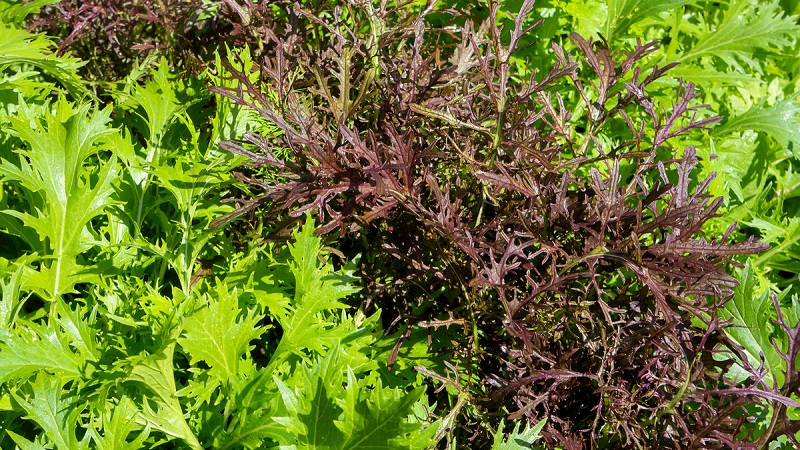
Mizuna Red has similar characteristics: forms a rosette of decorative carved purple leaves 40 cm high. Harvested 30–35 days after germination. Spicy radish taste.
Mermaid
The mid-season variety was included in the State Register in 2002... The plant forms a raised rosette of 45-60 leaves. Height - 35–40 cm, diameter - 65–75 cm. Leaves are green, lyre-shaped, pinnate with a smooth or slightly wrinkled surface. Petioles are white.
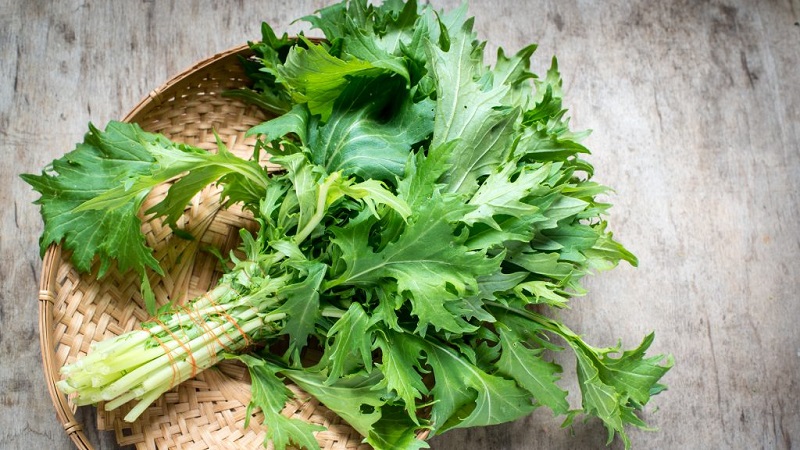
The crop is harvested in 60-70 days from the moment of the first shoots... The taste of the leaves is pleasant. The weight of one socket is 1–1.5 kg. The yield is high - 5–7 kg per 1 m². The plant is resistant to cold and heat, shooting. After cutting, the leaves grow back.
Emerald pattern
The medium early variety Emerald Pattern has been included in the register since 2015... Rosette type - slightly raised, diameter - 55-60 cm. Leaves are bright green in color with a pleasant taste.The plant is resistant to stem stemming.
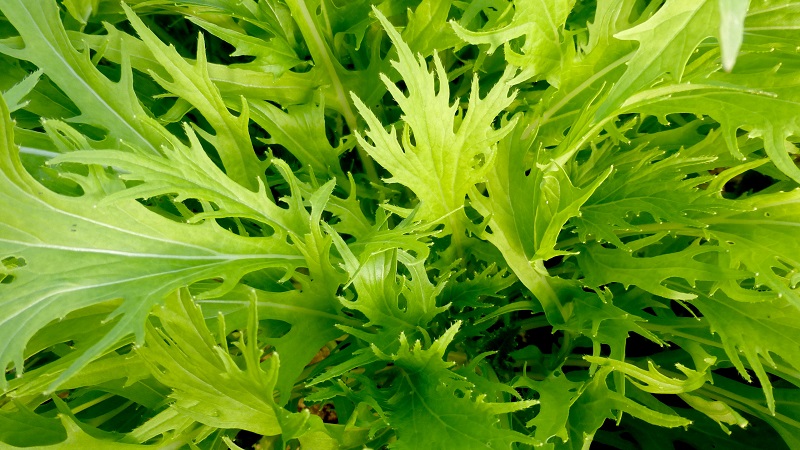
Weight of one plant - 500-700 g. Productivity - 5-5.5 kg / m²... Leaves are harvested 40-50 days after germination.
Dude
A mid-season variety is ready for harvesting in 30–35 days from the moment of the first shoots... Erect rosette with strongly dissected green leaves.
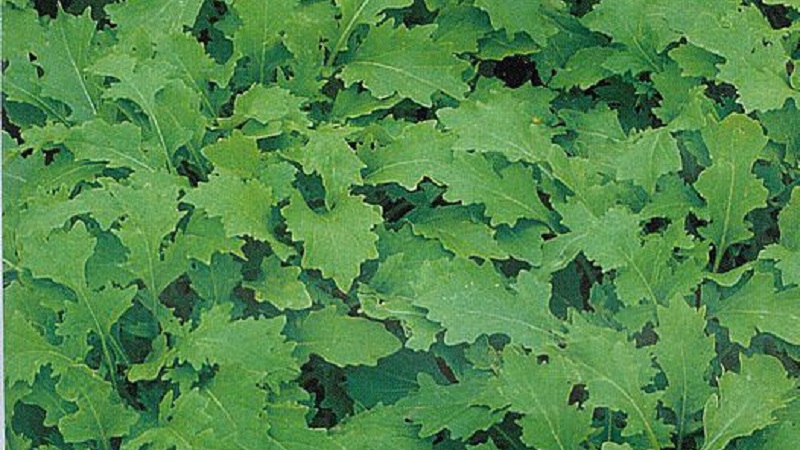
The weight of one plant is 350-500 g. 4-6 kg are harvested from 1 m².... After being cut, the greens grow back quickly. Recommended for fresh consumption.
The benefits of Japanese cabbage
Mizuna contains fiber, carotene, vitamins B1, B2, C, PP, calcium, potassium and iron... Strengthens the immune system, cardiovascular system, improves digestion, has antioxidant properties.
Important! Low calorie content (16 kcal per 100 g) allows you to include cabbage in the diet while losing weight.
Japanese cabbage is useful for people suffering from cardiovascular diseases and gastrointestinal disorders... Regular consumption of greens prevents the development of iron deficiency anemia.
Growing
Mizuna's agricultural technology resembles the technology of growing Peking cabbage... Sowing works are carried out in early spring and in the middle of summer.
The culture is unpretentious in care, cold and drought do not interfere with its development... It is recommended to grow mizuna in light, well-drained and organic soil. The acidity level is neutral - 6.5–7.2 pH.
Mizuna is planted after peas, beans, cucumbers, onions, beets, potatoes, tomatoes, alfalfa, flax, garlic. Unsuitable precursors - white cabbage and cauliflower, broccoli.

Sowing and caring for seedlings
Seeds for seedlings are sown in March - April in individual cups without further picking... Damage to the root system negatively affects the growth of seedlings.
Purchased planting material is not disinfected - it was processed before being packed in bags. Hand-picked seeds are soaked in a dark pink solution of potassium permanganate for 20 minutes and then dried on a paper towel.
Take ready-made substrate from a gardening store, disinfect it with a 1% potassium permanganate solution or warm it up in the oven. Plastic cups or peat pots are filled with moist soil and 2-3 seeds are sealed to a depth of 5 mm. The substrate is watered with warm, settled water, the containers are covered with plastic wrap, which is removed after the sprouts appear.
Seeds sprout in 7-10 days at an air temperature of + 20 ... + 22 ° С... The first shoots appear in 8-10 days.
Seedlings are kept on a windowsill on the sunny side, moisten as the top layer of the soil dries out. Japanese cabbage seedlings do not require special care.
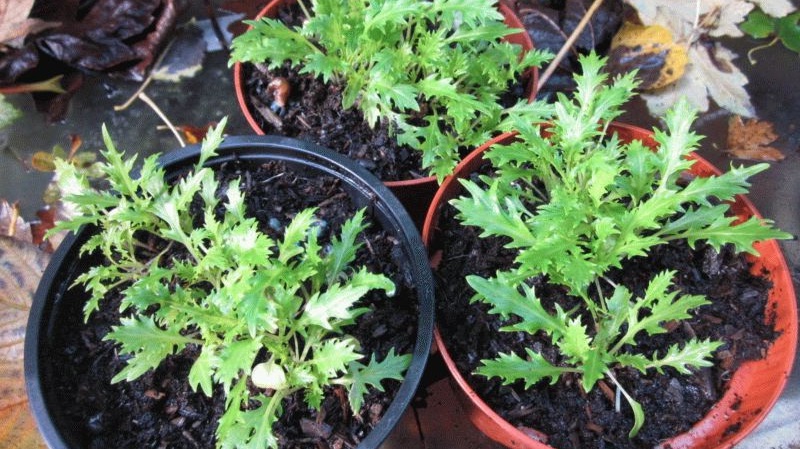
The hardened sprouts are transferred to open ground at the age of 17-20 days... Planting dates depend on the climatic conditions in the region. In the middle lane, this is done in April - May.
Council. For continuous harvest, cabbage is planted all summer, every 10-15 days.
On the site, holes are formed with a depth of 10 cm, seedlings with an earthen lump are loaded into them, sprinkle with soil and lightly press it with your palm. Sprinkle with warm clean water.
Seedless way
Direct sowing is carried out from April to August... In the southern regions, work begins in March, and in heated greenhouses, crops are grown all year round.
Council.Before sowing, the seeds are mixed with river sand to distribute them evenly over the beds.
Mizuna seeds resemble poppy seeds, so they are sown to a depth of 1-1.5 cm, observing the planting scheme 20 × 30 cm. Row spacing - 30–35 cm. Seedlings appear at a temperature of + 3… + 4 ° C. Favorable conditions for plant development are created at + 15 ... + 22 ° C. The plantings are covered with plastic wrap, which is removed after the first shoots.
Given the small size of the seeds, it is not always possible to maintain the correct spacing between them, so the plants have to be thinned out.
Read also:
General rules for planting in open ground:
- The soil in the selected area is fertilized with 5 liters of humus and 500 g of wood ash per 1 m². Then it is dug into ½ bayonet shovel.
- Heavy clay soil is mixed with river sand or sawdust. The fertility of sandy soil is increased with the help of humus.
- The optimum distance between seedlings is 25–30 cm.
- As the cabbage develops, the moisture level is monitored. The earth should not dry out, this leads to the shooting of plants.
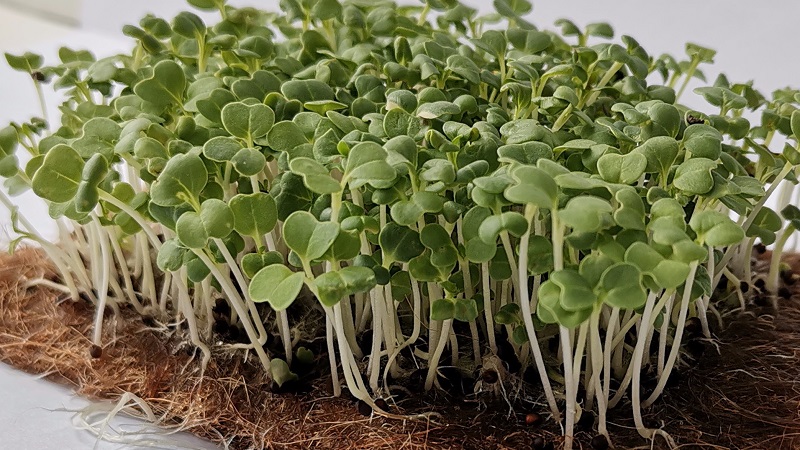
Care features
Taking care of Japanese cabbage plantings is easy. The main thing is to follow the recommendations:
- The beds are watered regularly, but in moderation. Excess moisture leads to decay of the root system, deficiency leads to drying out of the leaves. Water is poured under the root, trying not to get on the greens. Otherwise, moisture accumulated on the outlet will cause rotting.
- The soil around the cabbage is mulched with straw, peat, sawdust to retain moisture and delay the growth of weeds.
- Row spacings without mulch are weeded as weeds grow. The soil is loosened after each watering. This provides additional moisture and air flow to the roots.
- Top dressing is applied once every 14 days for a quick set of green mass. To do this, use wood ash in the form of a water suspension (200 g per 1 liter) or powder (200-300 g per 1 m²). Nitrogen and mineral fertilizers are not used for Japanese cabbage, since greens quickly accumulate nitrates. For the development of plants, there are enough compounds introduced into the ground during planting.
- Mizuna is a short day culture, so it is shaded to prevent shooting. A special fiber in a fine mesh is best suited for this. It is sold in gardening stores. Thin calico fabric is used instead of fiber.
Pests and diseases
Delicate Japanese cabbage leaves are the best cruciferous flea food... Its appearance is indicated by numerous holes in the leaves. To scare off the pest, marigolds, mustard leaves, calendula, garlic are planted next to the plants. The land around the bushes is powdered with ash or tobacco dust (200 g per 1 m²).
Important! Insecticides are not used, as greens quickly absorb toxic substances. The result of eating such cabbage is poisoning.
The culture is susceptible to fungal diseases - false dew and keel.
False dew appears as brownish-yellow spots on the leaves. To prevent infection, plantings are watered with warm water, crop rotation is observed and the soil is treated 24 hours before planting with 1% Bordeaux liquid (200 g per 1 liter).
Keela affects ornamental and vegetable plants... Signs of the disease: stunted growth, loss of color, shrinkage and deformation of the stems. For prophylaxis, seedlings are carefully examined before being transferred to open ground, weak and damaged ones are discarded. Before planting cabbage, the soil is limed (250 g of slaked lime per 1 m²).
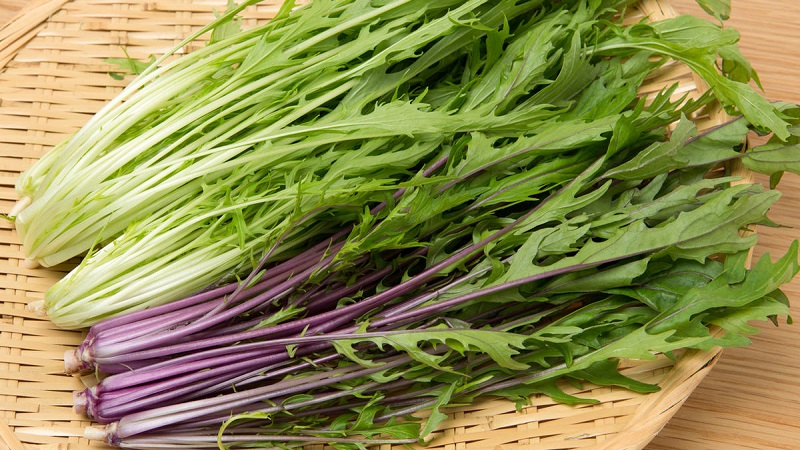
Reviews
Reviews of gardeners about Japanese cabbage are positive. Those who tried to grow it were pleased with the result.
Yana, Oryol: “I met Mizuna last year. The weather conditions in our region allow us to plant seeds directly in the ground and not bother with seedlings. Seedlings appeared in 1.5 weeks. The greens are lush, bright green, not afraid of cold weather. In the summer, however, the beds were attacked by a flea. Cope with it with the help of tobacco dust. After cutting, the leaves grow in a new way, so they got a fresh harvest until September ".
Igor, Krasnodar: “I have been growing Japanese cabbage for several years in a row. I really like its taste and appearance. I plant red and green mizuna. Greens are good in summer salads, but quickly wither after cutting, so it is advisable to eat them quickly. Once planted in partial shade for lack of space in the garden. I don’t do this anymore: the harvest was small, the rosettes were not so lush. Better to plant in a sunny place ".
Conclusion
Mizuna attracts with its delicious greenery and decorative look. The fluffy rosette is formed from green or red leaves.The plant does not shoot when planted in a sunny place, is unpretentious in maintenance and is suitable for growing in many regions of Russia.
Cultivation in heated greenhouses allows you to get fresh greens all year round. Cabbage loves sun and moderate moisture. The soil is regularly loosened and weeded, mulched, and fed with wood ash.